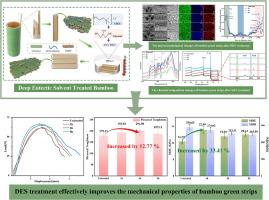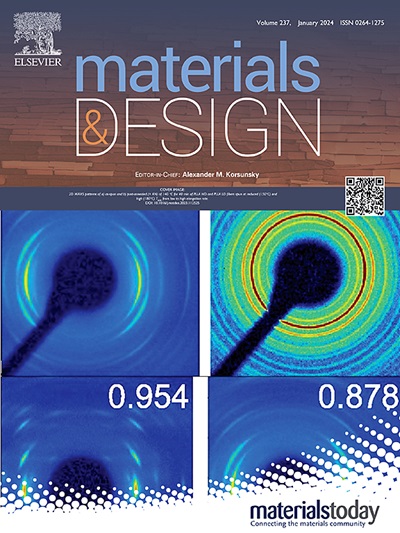通过改变硅成分平衡脱木素竹材的强度和韧性
IF 7.6
2区 材料科学
Q1 MATERIALS SCIENCE, MULTIDISCIPLINARY
引用次数: 0
摘要
部分去除竹材料中的木质素,是一种常用的软化材料以便塑性成型的方法。它能提高弯曲韧性,改善成型质量,但却牺牲了承载能力。本研究采用一种创新方法,利用深共晶溶剂对竹青条(BGS)进行预处理,在强度和韧性之间建立平衡,从而显著提高弹性模量。与竹材条(BTS)和竹黄条(BYS)相比,经过 DES 处理的 BGS 的机械性能有明显改善。值得注意的是,处理一小时后,BGS 的弯曲韧性和弹性模量分别提高了 8.22% 和 33.45%,而强度仅降低了 5.72%。同时,其孔隙率增加了 29.36%,主要集中在中孔范围。此外,经过处理的 BGS 结晶度增加,而晶粒尺寸减小。在 BGS 外表面形成的硅铝化合物,以及氧化硅含量的增加,都有助于提高硬度和韧性。这些研究提出了一种平衡竹结构单元模量和强度的新方法,有望应用于建筑、家具和交通领域。本文章由计算机程序翻译,如有差异,请以英文原文为准。

Balancing the strength and toughness in delignified bamboo through the changing of silicon composition
The partial removal of lignin from bamboo materials, a prevalent method to soften the material for plastic forming. It increases bending toughness and improves forming quality, albeit at the expense of load-bearing capacity. This study employs an innovative approach using deep eutectic solvent pretreatment on bamboo green strips (BGS) to establish a balance between strength and toughness, resulting in a significant enhancement of the elastic modulus. The mechanical properties of the DES-treated BGS displayed notable improvements compared to bamboo timber strips (BTS) and bamboo yellow strips (BYS), which either showed no enhancement or suffered degradation after extended treatment durations. Notably, BGS treated for one hour exhibited increases of 8.22 % in flexural toughness and 33.45 % in elastic modulus, while strength diminished by a mere 5.72 %. Concurrently, its porosity increased by 29.36 %, predominantly in the mesopore range. In addition, the crystallinity of the treated BGS increased, whereas the grain size decreased. Silicon-aluminum compounds form on the outer surface of BGS, along with an increase in silicon oxide content, contributed to the observed improvements in stiffness and toughness. These works suggest a novel method for balancing modulus and strength of bamboo structural units, with potential applications in architecture, furniture and transportation sectors.
求助全文
通过发布文献求助,成功后即可免费获取论文全文。
去求助
来源期刊

Materials & Design
Engineering-Mechanical Engineering
CiteScore
14.30
自引率
7.10%
发文量
1028
审稿时长
85 days
期刊介绍:
Materials and Design is a multi-disciplinary journal that publishes original research reports, review articles, and express communications. The journal focuses on studying the structure and properties of inorganic and organic materials, advancements in synthesis, processing, characterization, and testing, the design of materials and engineering systems, and their applications in technology. It aims to bring together various aspects of materials science, engineering, physics, and chemistry.
The journal explores themes ranging from materials to design and aims to reveal the connections between natural and artificial materials, as well as experiment and modeling. Manuscripts submitted to Materials and Design should contain elements of discovery and surprise, as they often contribute new insights into the architecture and function of matter.
 求助内容:
求助内容: 应助结果提醒方式:
应助结果提醒方式:


